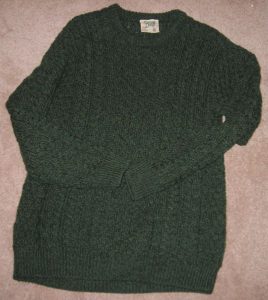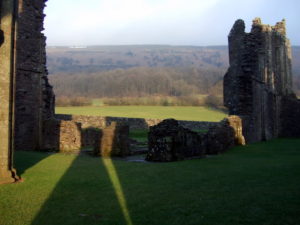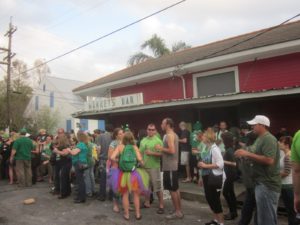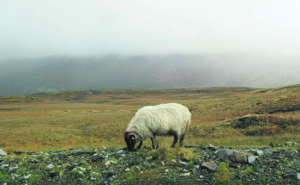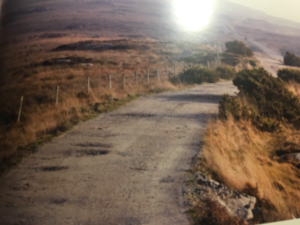Welcome to our page on the duality of Irish authenticity! We are Chloe, Alissa, Maeve, and Rebecca, four Geneseo students enrolled in a class centered on Irish landscape and memory. Our project explores how authenticity manifests among the Irish population, landscape, and global perceptions of the region. Specifically, we turn to the areas of Connemara and Killarney in Western Ireland which possess rich histories of tourism. Oftentimes these places are deemed to be “authentic” because the people are believed to be living lifestyles true to their culture as they interact with the land. However, as we will exhibit, the notion of authenticity is not as legitimate in Ireland as popular sentiment would have many believe. By examining authenticity in depth, scrutinizing the commodification of the people and landscape, analyzing advertisements, and assessing the struggle for Irish independence, our website will demonstrate how authenticity serves to benefit the Irish while simultaneously pressuring the populace to conform to a fabricated image.
Tourism Advertisement
This advertisement encompasses assumptions held surrounding the issue of authenticity in the effort to sell an image benefiting the tourism industry. It displays the duality of the presentation of the Irish people. A group is seen horseback riding on a beach, the horses galloping through shallow waves as the wind blows through their manes. In the very next scene, the image cuts to a street festival where people are dancing, singing, and playing instruments in what appears to be a spontaneous occurrence. In the former scenario, Ireland offers exotic adventure. Visitors can find athletic activity such as hiking or kayaking within a rugged, unexplored terrain. In the latter situation, the Irish are shown as avid partiers, engaging in celebration on a whim. This impulsive festivity relates to the pervasive stereotype of the consistently drunk Irish. It also reinforces the idea that people visiting can always locate a party or pub due to the natural tendency of the Irish to party. This constructed dual image limits the Irish populace by pressuring them to conform to overly simplified stereotypes.
In addition to how the Irish people are presented, this video portrays the double bind of the landscape. Some parts of the video focus on sweeping, panoramic images displaying land devoid of people. Others show people in a more contemporary city with paved roads and modern architecture. Possessing both appeals to a broader range of tourists; those seeking an escape from the industrial world can visit beautiful mountains and lakes, while those seeking social entertainment can visit the city.
It is clear in this advertisement that tourists are supposed to believe that Ireland is simple enough that a stranger can immerse themselves in the culture immediately. The narrator tells potential consumers, “from the minute you’re here, you’re one of us.” Such a notion is rooted in superficial authenticity. This is evident in scenes such as the fishermen using what appears to be hand-woven tools, or cows walking alongside a Volkswagen bus. This comparatively “primitive” society evokes a feeling of nostalgia that it appealing to tourists desiring to escape from a complex industrial world. Emphasizing the idea that Ireland is a place “you won’t find anywhere else in the world” brands the nation as a unique location of authenticity tourists will pay to experience.
Main Page
Irish Authenticity
The photos within this gallery represent the idealized authentic Irish landscape. These landscapes of Connemara and Killarney are void of any human presence, thus representing a romantic perspective of Ireland, in which the absence of people is part of the pleasure.
Ireland’s landscape is prominently known for the feelings of sublime it provides to those who bear witness to its raw beauty. It evokes an overwhelming sense of awe as the viewer observes its grandeur. In connection to the sublime landscape of Ireland, the unique authenticity of the state as a whole is another significant factor that draws travelers from all areas of the world with the desire to experience the true simplicity of a landscape pure and untouched. As stated previously above, the picturesque landscapes of Ireland provide a sense of an authentic Ireland seen through a romanticized lens.
However, the presence of sublime landscapes are not the only elements that help portray the image of an idealized, authentic Ireland. Two specific regions in Ireland, Connemara, located in the northwest corner of County Galway, and Killarney, located in County Kerry in the southwest, offer both the sublime beauty of Irish landscape and the image of an ‘authentic’ Irish culture to tourists. As pure depictions of sublime landscapes, both of these regions are known for attracting floods of tourists year-round with their rolling, green hills, quaint villages, and strips of rugged coastline bordering sparkling bodies of water. In addition to representing the romanticized landscapes that portray the authentic, idealized version of Ireland, other elements including the Irish natives themselves, representation of the historical Ireland, traditional craftsmanship, and physical remains of the past all encompass this concept.
Representation of the Historical
Representation of historical Ireland is another key factor that maintains the ideology of Irish authenticity. As a way to promote tourism, the Irish use the authentic Irish ‘image’ to their advantage. At Irish festivals, or large tourist attractions, people will dress up in traditional, Celtic costumes and play traditional folk music to advertise this image and boost tourism as many tourists seek to experience this unique aspect of traditional Irish culture. Furthermore, Connemara is one of the few remaining regions that continues to speak Gaelic. Maintaining the use of this traditional language contributes to the projection of legitimacy. This display preserves the image tourists have of Ireland; as a result, people seeking to experience the “authentic” are attracted to the area.
Work
Another means in which authenticity is promoted to attract tourists is through work. This prominently includes the work area of basic craftsmanship, like knitting. Tourist attraction videos portray this type of work in a pure and wholesome form. For example, hand-made, knit, sweaters are a huge commodity surrounding Irish tourism. The Irish use this to their advantage to attract tourists, seeking to experience the ‘authentic’ Ireland. By promoting this “authentic” image of Ireland through commodified goods, such as these sweaters, it feeds into tourists’ image of Ireland as an organic, authentic place, but especially benefits the Irish economy.
For tourists, hand-made sweaters represent an ‘authentic’ aspect of Ireland.
Remains of the Past
Past remains of Ireland continue to actively impact and connect to modern Ireland and its authenticity. The remains showcase the absence of people in locations where there was once an abundance. Ruins represent the loss of life and community; yet, the absence creates the aesthetic of an empty landscape which establishes romanticized authenticity. Travelers come to experience the true authenticity that Ireland claims to possess. Tourists come to the remains to witness the sublime. These ruins force outside observers to acknowledge the hardships and successes of the people who had once inhabited landscape. The ruins are a reminder of Ireland’s history. They make it impossible for travelers or the native people to escape it. They are captivated by them and are subjected to look at that the ruins and become overtaken with their emotions while being present at the remains. They have to face the truth of how they became what they are and the horrible events of the famine that made so many people lose their lives or forced to move away. If there were no remains left it would be harder to confront the historical past of remains and how everyone living a life within the remains vanished.
Figure 2:
Ruins in Ireland represent the loss of community in Ireland’s history.
Main Page
Landscape & Commodification
Western Ireland is highly desired for its naturally beautiful landscapes. These scenes evoke the inclination to control the sublime, for controlling the sublime is to obtain power. As such, the English adopted considerable interest in Irish affairs. Through the means of colonization, they commodified the Irish landscape. Viewing the land as potential for new markets, the English plundered natural resources for the purposes of benefitting their industrial endeavors. Constructing an economic system based on property ownership and industrial activity undermined the organic relationship the Irish people had previously established with their homeland. In addition to commodifying the landscape, the English commodified the Irish populace itself. What they perceived to be a primitive body of people presented the perfect opportunity to claim more laborers.
In Killarney, a shift in control over commodification began in the 18th century. Local wealthy families virtually acted as tourism-development agencies. They shaped the town into organized settlements and established accessible roads and transportation options. This allowed for the eventual formation of an Irish-owned industry of tourism.
In both Killarney and Connemara, the aftermath of the Great Famine of 1852 served as a major turning point in the evolution of tourism. The Famine decimated the Irish population, resulting in a landscape uninhabited by many people. This contributed to a “picturesque” spectacle that drew tourists to the area. Regarding this as an economic opportunity, the Irish proceeded to commodify themselves. By choosing to develop the tourism industry, the Irish people reclaimed agency and escaped the depression partially caused by British influence.
The 19th and 20th centuries saw a revival in Celtic culture accompanied by a return of traditional Gaelic language, music, art, literature, sports, and stories. The Irish sold images of authenticity to consumers. By embracing expectations of Irish behavior, Ireland commodified the authentic and placed the power of the economy under Irish control.
Today, the presentation of Irish tourism is in a double bind as two different images are sold. The older notion of the empty, picturesque landscape still stands. Yet, the presence of people has been commodified as well. These two ideas conflict with one another, because people soil the “perfect” landscape. Making spaces accessible to people disrupts the sense of isolation and potential for adventure associated with empty land. This double bind is evident in different activities tourists can participate in when visiting Ireland.
Figure 1:
Traditional Irish attire enforces the festivity of the celebration.
Tourists take advantage of the natural landscape of Ireland by hiking.
In many advertisements, the Irish people are portrayed as “adventurous” and “welcoming.” They are depicted dining in upscale restaurants, engaging in athletic activities, and socializing in festive gatherings. This is clearly seen in Figure 1, in which Irish people are dressed in festive costumes, drinking at a pub, and reinforcing a celebratory atmosphere. Other advertisements utilize a more traditional representation of Ireland: rugged wilderness and desolate landscapes. Figure 2 shows people taking advantage of this type of scenery by hiking among rolling hills. Both of these presentations of the Irish populace fortify the idea that Irish identity lacks complexity. Believing it to be exceptionally simple, tourists traveling to Ireland think that they can immerse themselves within the local culture easily and without lasting consequences. This is deleterious to the perceived identity of the Irish people because it perpetuates superficial stereotypes. Nonetheless, as the industry attempts to cater to a wider range of consumers, both the Irish landscape and people continue to be commodified in the interest of benefitting tourism.
Main Page
Imperialism and Irish Agency
For a major portion of the Irish population, the reaction to British imperialism involved reclaiming what was considered “Irish tradition”. The Irish nationalist Eamon de Valera made the argument in a 1943 speech that the universality of the Irish language is the key to authentic nationhood in Ireland. His hardline rhetoric is representative of the nationalism that made waves throughout Ireland during the 20th century. The notion of a return to what is “authentic” is what became the backbone for the tourism industry in Ireland and also what became the basis for the assertion of Irish stereotypes from an international perspective.
The late 19th century in Europe was a time of national uncertainty and change. In Ireland, the extended history of British oppression drove the question for what defined Ireland. The Gaelic League formed during this time in an attempt to return to what is authentically Irish, and also in an attempt to claim something that can belong to Ireland alone, such as language. De Valera’s ideal outcome of establishing Gaelic in Ireland is that it would be the basis for something essentially Irish in the nation. The problematic outcome that emerged in the 20th and 21st centuries is actually the emergence of the tourism industry in Ireland, in which the aspects of the nation that de Valera would argue are “essentially” Irish are actually sold to an international market and used for profit instead of practical use.
However, the commodification of what is “traditionally Irish” became a foundation for a major part of the revenue that the nation generates as an independent nation. Prior to the independence of Ireland, Great Britain would profit from the exploitation of the Irish landscape from tourism. British imperialists saw that they could benefit from selling the notion of the sublime in Ireland; however, this required the separation of the landscape from the Irish people, in which the absence of people would only benefit the sublimity of the land. In modern tourism, the Irish are sold along with the landscape by acting as “traditional” people of Ireland. Advertisements show this duality between the commodification of people as extensions of the landscape and commodification of the landscape on its own. The difference between Irish tourism as operated by the Irish themselves and tourism as operated by British imperialists is that the Irish people have a role in their own landscape and that they are the people making a direct profit from this tourism.

Figure 1:
A traditional house represents the authenticity that is commodified
Connemara and Killarney are the perfect representations of idealized authenticity in Ireland. While these regions are best known for the traditional culture that they seem uphold, In western Ireland, local farmers and businesses benefit from tourists who seek to experience the “authentic” Ireland. In Connemara and Killarney, this experience is sold to tourists in the form of hand-made goods and the image of a simple daily lifestyle. For tourists, these regions represent a perspective of life back in 19th century Ireland.
Figure 2:
A sheep!
The landscape in these regions represent something that has been lost in time, such as tradition. Unpaved roads and traditional houses as seen above are typically associated with these areas, and the absence of technology is a part of the commodification of this experience. Many who seek the “authentic” that is represented by this region participate in the local economies of Killarney and Connemara. Farms, local co-operatives, sawmills, and medical facilities occasionally employ outsiders of the region. This kind of tourism benefits local economies while promoting the notion of authenticity as perceived by the international community, therefore generating more tourism.
Figure 3:
Unpaved roads signify an absence of technology.
Despite the benefit of tourism to the local communities of Connemara and Killarney, this commodification of landscape and the Irish people limits the international perspective of Ireland. The true authentic Ireland is lost among the conceptualized authenticity that is sold to outsiders of the community. This perception of Ireland is marketed in a way that enforces blatantly stereotypical images of Ireland in celebrations such as St. Patrick’s Day in the United States.
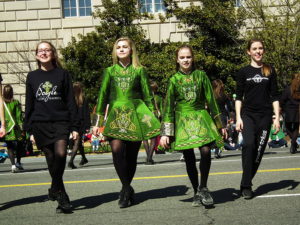 Figure 4:
Figure 4:
Irish step dancers perform in a parade in Washington D.C., 2012.
International celebrations of this holiday typically pair the traditional with the stereotypical. While St. Patrick’s Day features traditional cultural practices such as step dancing, it is unfortunately better known for its glorification of alcohol.
Main Page
The Duality of Irish Authenticity
“If beauty is to have any role at all, it must co-exist with something else to give it meaning.”
- – Hugh McElveen
Western Ireland is known for having some of the most breathtaking and visually engaging landscapes. The landscapes are known for drawing travelers from all corners of the world, whether it is people who desire to experience the true authenticity of the Irish culture, or those in search of the sublime landscape that Ireland is known for. Advertisements enticing consumers to travel to Ireland display exaggerated notions of the landscape. How did tourism reach this point?
Here, we will focus directly on two distinct locations in Western Ireland: Connemara and Killarney, both of which are known for their rustic, authentic portrayal of the Irish culture and landscape. These two specific case studies serve as examples of the commodification of the Irish landscape, people, and culture.
Irish tourism is rooted in a history of colonial oppression, and has since become a source of Irish agency. Ultimately, the industry has emerged as a crucial source of national income and allows for greater autonomy. As tourism has evolved over time, Irish authenticity has come into question.

